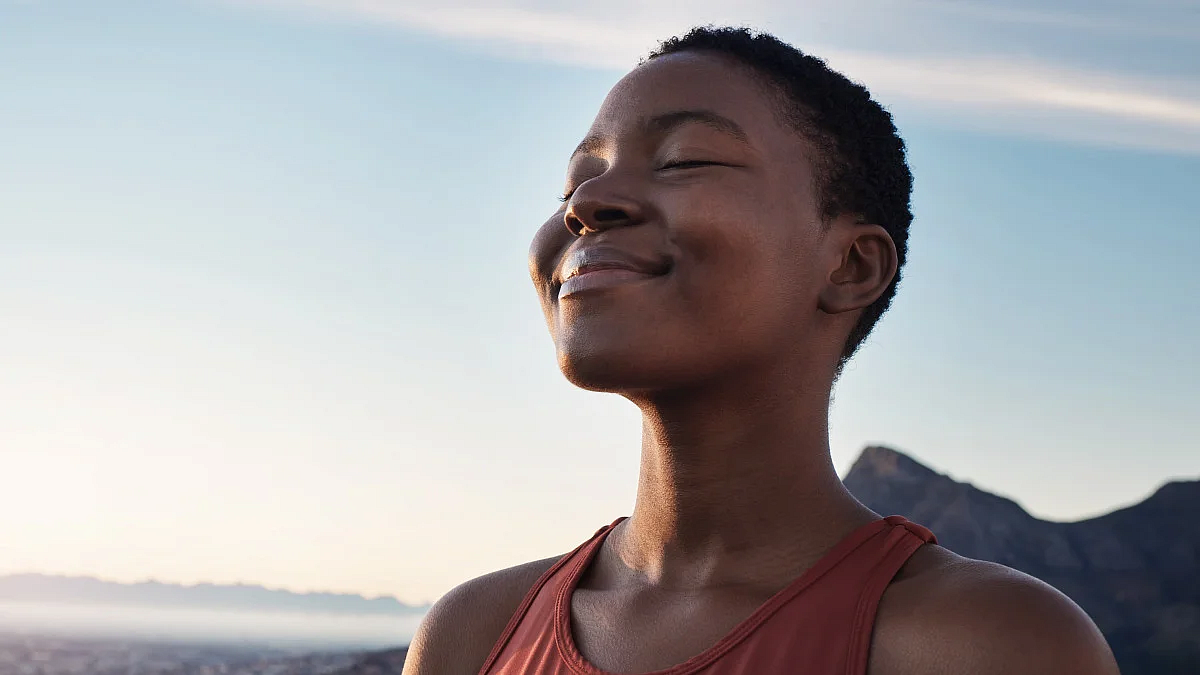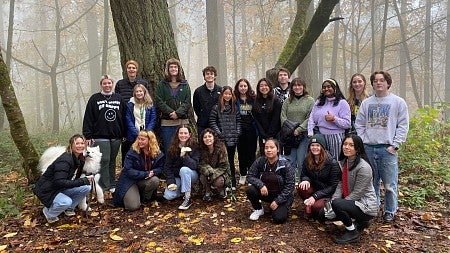
Experiential Learning | Research & Innovation | Community Impact | Career Preparation | Teaching Excellence | 21st Century Liberal Arts | Building Community | Good Vibes | CAS Spotlights | All Stories | Past Issues

Free Your Mind—and Peace Will Follow
The thought of practicing mindfulness might conjure images of a solitary figure sitting in silence. But the good news is that you don’t need to be a monk—or a Jedi—to get started with mindfulness. You can incorporate it into everyday routines.
That’s what David McCormick, a Presidential Chair, professor of biology and director of the Institute of Neuroscience at the University of Oregon, found out while teaching neuroscience to Buddhist monks in Tibetan monasteries in India.
McCormick recalls asking the monks how often they would meditate each day. They answered that they were meditating all day long, being present in whatever they were doing.
Starting a mindfulness meditation routine can seem intimidating, especially since it requires learning how to disconnect from devices and be in the present. But McCormick, who teaches the popular elective course Happiness: A Neuroscience and Psychology Perspective, offered in the College of Arts and Sciences, has some tips for incorporating mindfulness into everyday routines.
“You can be mindful in just about anything, especially routine things: showering, dishwashing, walking, eating, before you go to bed,” McCormick says. “That has the added benefit that it’s not only a meditation that I do at 9 p.m. in the corner of my room.”
The positives of mindfulness
It’s easy to spend time mulling over the past or worrying about the future. But focusing on the present with mindfulness meditation can improve your physical, mental and social health, according to Megan Lipsett, a doctoral candidate who works with McCormick.
Lipsett has a Mindfulness-Based Stress Reduction certification, considered a gold standard in mindfulness training. She’s also on the advisory board for the Center for the Science and Practice of Well-Being, created by McCormick with the mission to enhance the mental well-being of the campus community.

Randomized controlled trials—one of the most rigorous ways to test—have shown a decrease in chronic pain and a reduction of disease risk when practicing mindfulness, Lipsett says. “In large part, this is due to the way mindfulness can buffer the impact of stress on the immune system,” she adds.
Practicing mindfulness can help curb smoking and reduce consumption of low-nutrient foods. It can reduce symptoms of stress, anxiety, depression and post-traumatic stress disorder.
Practicing mindfulness also is a way to address the inner critic we all have. Judgments about ourselves and the world become habitual—something that occurs in the absence of our full attention. But being present and paying attention can help us unpack our judgments, whether they're related to pain or preconceived beliefs.
“Learning to be with the nuances and really pay attention,” Lipsett says. “Rather than, ‘I’m in pain,’ ask if you feel heat, is it constant or does it go away? And the same with our emotions. ‘I’m feeling very angry.’ What does that feel like? It’s a lot of noticing—rather than labeling—and being curious about our own experience.”
Getting started with mindfulness
McCormick’s popular elective course has grown from nearly 100 students when it was first offered about three years ago to more than 650 for the 2023 fall term. During the course, he reminds students that they do indeed have time to practice mindfulness and encourages them to notice how much time they spend on their phones during downtime, which can be several hours a day.
“The biggest perception people have about why they don't do mindfulness meditation or meditation in general, is they feel like they don't have the time,” McCormick says. “For most people, there is time. Our perception of having time or not is more about, ‘What do I prioritize?’”
To get started with mindfulness, McCormick says, sit with your back straight and your neck in alignment with your back. “It’s not a slouching posture. It’s an attentive posture because you’re paying attention,” he says. “But it shouldn’t be painful.”
Just breathing mindfully can make a difference. So, inhale and exhale because breathing is the foundation of mindfulness.
“That can be done anywhere with no tools—just pause, listen and watch a full breath cycle,” Lipsett says. “Your mind will wander because that’s what it does but bring your attention back to breathing.”
Enhancing your everyday routines
Having a mindfulness meditation routine has its benefits, but McCormick has some suggestions for staying present in your everyday routines, such as brushing your dog’s fur.
“I just feel the texture of her hair, how soft it is, the feeling of the motion, the temperature of her, and I notice where the snags are,” he says about brushing his dog Sasha’s fur.
Meditative eating is another way to be in the present. Rather than eating quickly in front of a TV, McCormick suggests basking in the joy of eating.
“Our society trains us to be anxious by throwing anxiety-provoking stimuli in our face all the time to get our attention,” McCormick says. “You need to retrain your mind and realize, ‘Hey, you know what, if I'm eating this food, I should just eat this food and enjoy it.’”
Meditative walking can turn an ordinary stroll into a mindfulness exercise. McCormick recommends observing the movements of walking, how your foot strikes the ground and arms swing. Observing the colors of the trees, the flutter of the wind and your surroundings also can help you remain present.
But mindfulness doesn’t mean you need to make your mind blank. McCormick tells students to approach meditation with a self-distancing technique. If thoughts and emotions come to mind, try not to dwell on them or let them draw you into their story. Just simply listen and be curious—learn what your thoughts and emotions have to say, but from a distance.
“You might have your thoughts or emotions come up,” McCormick says, “but they’re like a cloud drifting by and you can observe them.”
—Henry Houston, MA ’17 (international studies), is a communications coordinator for the College of Arts and Sciences.
—This work is funded by the Tiny Blue Dot Foundation, which seeks to fund neuroscientific research related to expanding people’s Perception Box.
